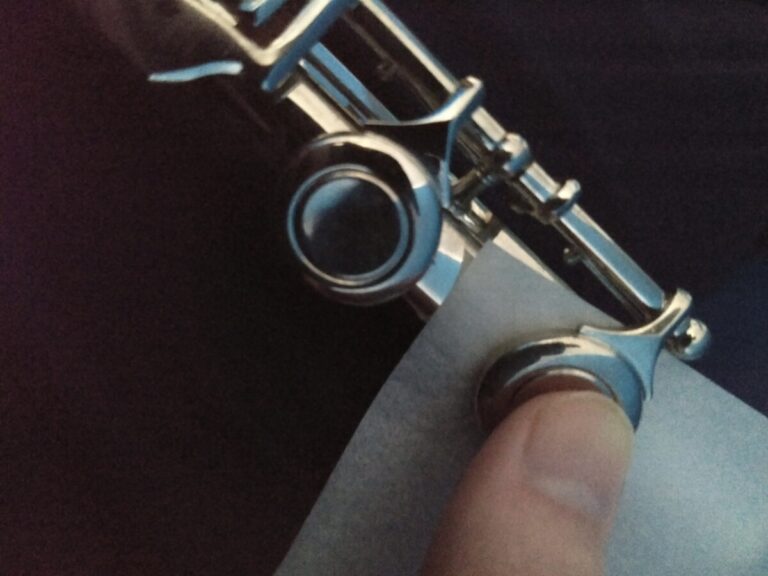Why is My Flute Turning Brown?
If you are a flutist who plays on a silver flute, you may have noticed at some point that your flute began to lose its luster and turn brown. If this is the first time this has happened, you might be alarmed and worried about possible damage to your flute. So, what’s going on?
Flutes turn brown due to tarnish. The tarnish is the result of a chemical reaction between the silver of a flute and the various compounds it comes into contact with. Tarnish on a flute is not an immediate problem, and will not significantly affect the sound of a flute. Even so, it may cause problems if allowed to fully erode, so it is best to clean the tarnish off.
Our goal is to help you understand exactly what causes tarnish and what to do about it so that you can keep your flute in top-condition all the time. More importantly, we will discuss what not to do when cleaning your flute, since there are many ways to accidentally damage it while trying to clean tarnish.
What is tarnish?
In general, tarnish is a chemical reaction between any metal and a nonmetal compound. In the case of the silver on your flute, the tarnish comes from the silver reacting with hydrogen sulfide, a gas which is present in extremely small and usually harmless quantities due to air pollution. The process of tarnishing is sped up by oxygen, various oils in your skin, and heat.
Since the tarnish is caused by a chemical alteration of the silver, it cannot simply be “wiped off.” Assuming that you could even manage this, it would damage the flute since you would also have to “wipe off” some of the silver. However, there are measures that can be taken to separate the hydrogen sulfide silver from the silver, leaving the flute unharmed.
What causes tarnish?
Though the cause of tarnish on a flute may technically be the hydrogen sulfide, the fact still remains that some flutes will tarnish while others will not, even though their exposure to hydrogen sulfide is about the same.
For practical purposes, there are four factors which you need to know about which are causing your flute to tarnish much faster than it otherwise would:
Exposure to open air
Always make sure that you keep your flute safely packed away in its case when you are not using it. It might be tempting to leave your flute sitting out so that you can easily just pick it up later and start playing, but don’t do that. The more that you leave your flute out, the more likely it is to tarnish.
Excessive exposure to saliva
Given that the flute is a woodwind instrument, it is inevitable that it will come into contact with saliva. This in and of itself is not a bad thing. It is a problem when you do not clean out the inside of your flute, and simply let the saliva accrue inside of it. It is always important to make sure that you swab out your flute after every time you play. We’ll talk more about swabbing in the “prevention” section of this article.
Oils in your skin
Sure, it might be common sense to clean out the inside of the flute, but don’t forget to clean the outside as well! Over time, the oils in your skin will speed up the process of tarnishing if you allow them to stay on your flute for long periods of time.
Heat
It seems that heat is always a problem for wind instruments because it alters their intonation. For flutes, however, heat can be especially irritating because it speeds up the chemical reaction occurring between the silver and the hydrogen sulfide. This should make sense; if you think back to chemistry, you always used a Bunsen burner to speed up reactions. Even though you aren’t exposing your flute to an open flame, having your flute outside on a hot and muggy day or even just an excessively warm and humid room can speed up the process of tarnishing.
Is tarnish harmful?
Tarnish on the outside of the flute is almost never harmful in the short-term, but it may cause problems if allowed to accrue. The most problematic spots to have tarnish are on the machinery of the flute or the inside of the flute, as this may slow down the keys or affect your sound. Even so, it should not cause permanent damage provided that you can get it removed within a reasonable amount of time.
Some musicians actually prefer the look of a tarnished flute, and will leave it tarnished. However, I would take caution in choosing this option for your own flute. Although damage from tarnish is uncommon, I have known some to report it when it accumulates over the course of years in excess.
How to remove tarnish
You have to be careful in the way that you go about removing tarnish. If you do it incorrectly, you can cause significant damage to your instrument. Make sure that you are being gentle, and avoid trying to clean the machinery of the instrument. The mechanical parts of the flute are too fragile to risk cleaning by yourself, and the inside of the flute might be too difficult to safely reach. For those parts, it is better to take your flute in to a trusted repair technician, preferably one who specializes in the flute.
When it comes to removing tarnish on the outside of your flute, your best bet is to use a microfiber cloth with alcohol. However, you must be careful with this method to never allow the alcohol to touch the pads underneath the keys. This will destroy the pads, and replacing them is an expensive repair.
Also, always make sure that you apply the alcohol to the cloth, rather than applying the alcohol directly to the flute. The alcohol should not harm the metal as long as you follow this tip.
That being said, you’ve got two good choices of alcohol that you can use.
Isopropyl alcohol
This is perhaps better known as “rubbing” alcohol, and you can find it easily on small, inexpensive wipes. You can even use the wipes directly on your flute, provided that you take care to avoid the pads and machinery. They are great for when you are playing outside of your home, when you might not have your other cleaning supplies.
Denatured alcohol
This is much stronger than isopropyl alcohol, but is incredibly effective at cleaning tarnish. Denatured alcohol is intended to be a potent cleaning agent, and it tends to come in paint thinner-like cans. You can use denatured alcohol to clean the body of the flute, but you must make sure that you take the proper precautions. As mentioned previously, always apply the alcohol to a microfiber cloth, rather than pouring the alcohol on your flute. Do not ever pour the alcohol into your flute under any circumstances. The head joint in particular has a cork in it, and the alcohol will dissolve it. Avoid cleaning anywhere near the pads or machinery. For those parts, it is better to find a trusted repair technician.
What NOT to do
I’ve already discussed some things that you shouldn’t do when cleaning tarnish with alcohol, but there are a few other tarnish-cleaning “tricks” that you should always avoid when it comes to flutes.
Do not use silver polish
While this might effectively return your flute to its former luster, it will also do more harm than good. Silver polish will actually remove a small layer of silver, wearing down the flute little by little. Furthermore, if any of the silver polish touches any of the machinery of the flute, then it will slow the movement of the keys down permanently. One mistake with silver polish can ensure that your flute will never play the same again.
Do not use toothpaste
I mention this only because this “trick” is sometimes tried or tossed around as advice. This might not remove a layer of silver, but it will still slow down the machinery of the flute.
Do not dunk the flute in any kind of fluid
That might be a method of cleaning brass instruments, but it isn’t a way to clean a woodwind instrument like a flute. Flutes (and other woodwinds) have pads and complex machinery, and drenching either of those will completely ruin them.
Prevention of tarnish
The better alternative to eliminating an issue is to find a way to prevent the issue from ever happening in the first place. Of course, if you were searching for why your flute is turning brown, then you are already having the issue. Nonetheless, hopefully I can still help you prevent tarnish from ever happening again after you get it taken care of.
Always store your flute in its case
This is one of the best things you can do to prevent tarnish if you are not already doing it. Leaving your flute exposed to open air will greatly accelerate the rate at which it tarnishes.
Regularly clean your flute
After you finish playing, make sure to wipe down the outside of the flute with a dry microfiber cloth. You can even wipe the top of the keys (though not the machinery), but be particularly gentle on those. Also make sure that you swab the inside of the flute. For this, it is best to use a non-fibrous cloth, preferably one which was designed for cleaning instruments. Otherwise, it might leave fibers which get stuck in the instrument and cause other issues.
Use silver saver paper
Most people aren’t familiar with silver saver paper, but it is one of the most effective and safest ways of preventing tarnish. Silver saver paper will naturally absorb hydrogen sulfide, preventing your flute from getting tarnished in the first place. All you have to do is leave the paper in your flute case; you don’t have to use it to wipe the flute down or anything like that. Replace the paper once every four to six months, and you should be all set.






